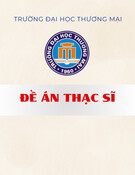
1
SUMMARY OF THE THESIS
1. The need for research
Investment activities in the enterprise were carried out on the following
fields: investment in construction, investment in human resources development,
R & D investment, investment in marketing and investment in intangible assets,
etc, and all referred as development investment in enterprises. Theoretical and
practical evidence has shown the impact of these investments on the business
results of the business. However, apart from the "formal" investment
expenditures, businesses also have to pay money that the law does not officially
recognize; this money is used to bribe, lubricate, bribe, etc and referred as
"informal costs". These two segments are not only isolated but also closely
related, the same is the investment content of the business, just one side of the
current and one hidden side, as a side painting side when increasing one factor
will reduce the remaining factor. The issue is how these areas affect the results
of business production of the business? Which sectors impact sustainability,
which array is short term? Which is more profitable for businesses?
In fact, research is needed to analyze and assess the impact of developed
investments and informal expenses on business performance. From that, we
propose solutions that help businesses to develop a sound investment strategy,
improve their competitiveness and business efficiency, and pay more attention
to technological or product innovation - Developed in today's harsh international
competition environment.
On the subject of research, the author decides to choose small and
medium enterprises (SMEs) because SMEs occupy a large proport on of the
whole enterprise (over 97%), which is an important part of the economy. the
developing market in Vietnam. Together with the private sector, SMEs are an
important driving force for development. With limited resources, SMEs face
many difficulties in the production and business process, and are also vulnerable
to the unhealthy nature of the business investment environment such as complex
administrative procedures and infomal costs.
When a company has large resources, spending money on developed
investment or informal financing is not a difficult decision to make. However,
for SMEs, a characteristic of this group of enterprises is the limitation of
resources (finance, human resources, material resources), thus limited in
capacity (production capacity, R & D capacity, competing capability). The
allocation of finite resources for capacity building is always a challenge for
SMEs. In the context of current development, in addition to allocating capital for
developed investment to renovate technology equipment, capacity building,
2
SMEs also have to spend a considerable amount to spend for the infomal costs,
make the development of SMEs is more difficult when the limited capital
resources have to be distributed to many, while uncertainty of what actually
benefits. This fact shows that studying the effects of developed investment and
informal costs on SMEs performance, identifying the problem and explaining
the causes of the problems is needed. It also helps SMEs better understand the
impact mechanism, and helps the government to have policies to ensure the
development of SMEs in accordance with the objectives, ensuring the important
role of the SMEs sector in the economy.
2. Purpose of the study
- Give a new perspective on the investment of the business, in that the
informal costs are also an investment. Investment activities of the enterprise
include investment in development (such as investment in human resources,
investment in fixed assets, R & D investment), and informal investment (is the
investment for informal costs)
- Develop a model for assessing the impact of formal and informal
investment on SMEs performance, especially to distinguish between short-term
and long-term impacts, from which to find out what is the factor to play a key
role in raising the SMEs performance, affecting the sustainable development of
SMEs.
- Propose solutions / recommendations to the SMEs community in
making decisions on allocation of investment capital: developed investment or
informal costs; Propose to the Government to promulgate mechanisms / policies
to support enterprises, improve business climate.
3. Subjects and scope of research
Research subjects: Developed investment in SMEs (focus on fixed asset
investment, investment in human resources and investment in research and
development R & D); informal costs of SMEs; SMEs perfomance; Impact of
developed investment and informal costs on SMEs perfomance.
Research scope:
Spatial: Study of SMEs, private sector, in the field of production, in Nghe
An province.
Time domain: Because the research results of the thesis have the results of
business production in the short and long term, the data collected also need a
long time. Author selects a time frame of 6 years, from 2011 to 2016.






























